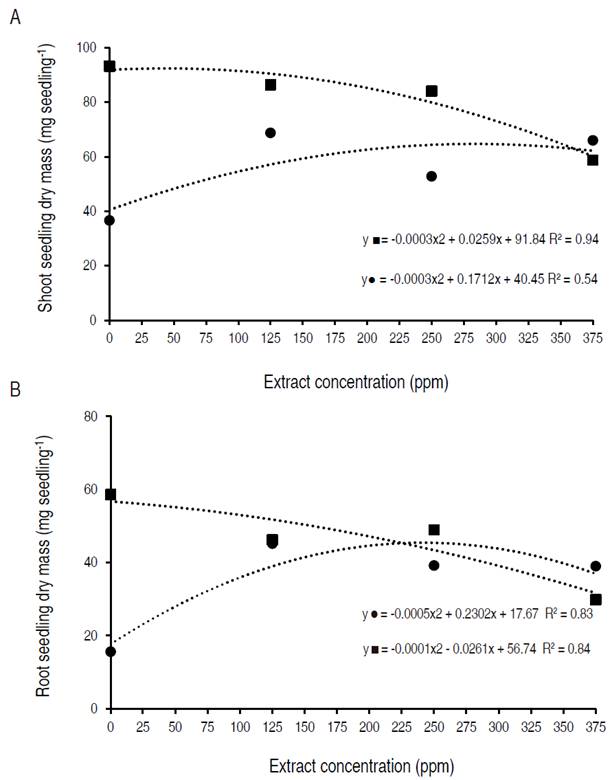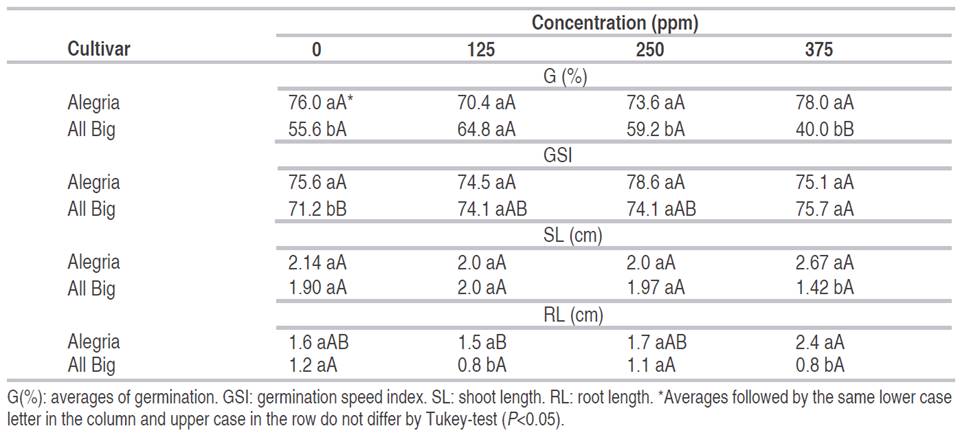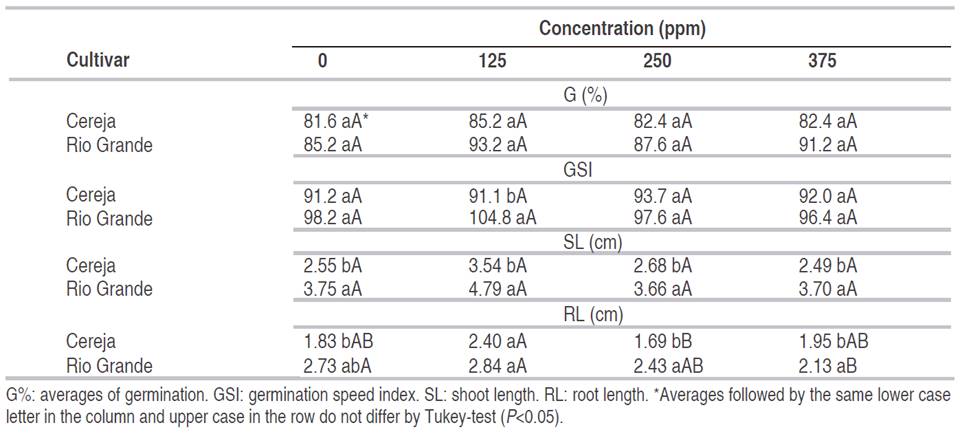Peppers and tomatoes are among the most produced vegetables in Brazil. They are consumed commonly as raw vegetables and condiment. In 2016, Brazilian's production was 544,900 t of sweet peppers (CNA, 2017) and about 4.1 million t of tomatoes in 2018 (FAOSTAT, 2018).
About 82% of these crops correspond to family farming units (IBGE, 2017). The production of these vegetables has a high value-added per area and a fast-financial return compared to other activities. However, this activity requires a large investment, especially in the purchase of inputs, which creates an obstacle to the productive system (Vendruscolo et al., 2017). Different methodologies should be explored to improve the production process and the profitability.
In addition to this, the large number of pests and diseases is an important issue of these crops that could be mitigated by a seed treatment. This option may improve the physiological quality of plants such as growth and development while protects against pests and diseases (Sharma et al., 2015). According to Mauri et al. (2019), the absence of seed treatments can increase severity of attack by pests and diseases reflecting on a low germination and growth.
Organic agriculture system has modified the standard production dabbling sharply on the market without chemical treatments (fungicides and insecticides), which are not allowed in this kind of agriculture (Mauri et al., 2019). Seed priming consists in a controlled hydration of the seeds, which can be used to improve the percentage germination and induce resistance to stress (Papparella et al., 2015; Waqas et al., 2019).
This technique is provided at the beginning of germination, with phases I (imbibition) and II (mobilization of reserves) without protrusion of the primary root. Traditionally, seed priming is performed with water under suitable conditions. However, some studies show that osmotic substances, bioactive molecules and secondary metabolites can be used. Species of vegetable such as lettuce, pepper and eggplant have been tested with this technique (Papparella et al., 2015; Forti et al., 2020). For instance, Delian et al. (2017) found that this technique can enhance germination, vigor and productivity of tomato seeds while promoting stress tolerance. Seed priming induces the antioxidant response and the DNA repair processes associated with the pre-germinative metabolism (Forti et al., 2020).
Seaweed is another biopriming treatment that has showed a positive effect on improving growth, productivity, and stress tolerance. A wide range of seaweed species has been used in agriculture as biofertilizers and biostimulants (Madruga et al., 2020). The brown seaweed Ascophyllum nodosum is found in the Arctic seas and on the rocky shores of the Atlantic, contains substances such as cytokinins, auxins and gibberellic acid, which make it an alternative as bioregulators. They act in oxidative and metabolic processes and have macro and micronutrients that can assist during plant growth (Ali et al., 2019; Castro, et al., 2019).
Priming of chicory seeds with A. nodosum caused an increase in the percentage and seedling emergence speed in greenhouse conditions (Ferraz et al., 2019). Spinach, canola and barley were evaluated by Saeger et al. (2019) finding a positive impact on the germination and development. Sivritepe and Sivritepe (2016) observed that seaweed priming on tomato seed can increase the germination speed and uniformity. Souza et al. (2017) found a significant increase in plant height, number of leaves, stem diameter and length of roots at 0.9 mL L-1 using seaweed extract on tomato seeds.
In this context, the objective of this study was to evaluate the effect of A. nodosum extract on sweet pepper and tomato seed quality.
MATERIAL AND METHODS
The research was conducted in a Grain and Seeds laboratory at Federal University of Fronteira Sul, between February and October 2019. Pepper seeds of the All Big and Alegria cvs, and tomato seeds from Cereja and Rio Grande cvs were used. A. nodosum extract (brown alga) was used as conditioner at 0, 125, 250 and 375 ppm according to Sivritepe and Sivritepe (2016) for each species and cv. The experimental design was 2×4 factorial scheme (cv×concentration) completely randomized. To identify the pattern of solution absorption of the seeds, soaking curves were made with the different concentrations of the extracts.
Imbibition curve
It was performed with methodology adapted from Ferreira et al. (2013). Four replicates of 0.2 g of seeds for each treatment were soaked in the solutions in plastic Gerbox-type boxes with metal plates and previously moistened Germitest papers (2.5 times their weight) at 25 °C, in a germination chamber until protrusion of the primary root. To determine the ratio water/solution absorbed, the seeds were removed from the Gerbox and dried using paper towels and weighed on a digital balance with an accuracy of 0.001 g at 60 min intervals after the first 12 h, every 3 h from 12 to 36 h, and every 6 h from 36 h; when the primary root protruded, the process was interrupted and the time was recorded in order to calculate later the appropriate time for seed priming procedure. After that, the water/solution absorption data were submitted to regression analysis to determine the imbibition period. This period was different for all species; for the pepper Alegria cv was 24 h, All Big cv was 15 h and for both tomato cvs was 18 h.
Seed priming was performed using a similar methodology to the soaking curve; however, the periods were determined by analyzing the results of the curve. Afterwards, the seeds were submitted to the germination analysis.
Germination test
Five replicates of 50 seeds were placed in plastic boxes of the Gerbox-type (11×11×3.5 cm), on two sheets of moistened Germitest paper, using distilled water by 2.5 times their mass. The boxes were kept in a germination chamber at 25 °C. The evaluations were performed at 7 and 14 days after sowing (DAS) according to Rules for Seed Analysis (MAPA, 2009).
Germination speed index. The number of germinated seeds was counted daily, during the 14 days of the germination test; the germination speed index was calculated by Maguire (1962).
Seedling length. It was determined using a methodology adapted from Nakagawa (1999). Randomly, 20 seedlings from each repetition were taken from the germination test at 14 DAS. These were measured with a graduated ruler and the values were recorded in cm.
Seedling dry mass. After determining the length of seedlings, they were put into Kraft® paper bags and placed in an oven with air circulation at 65 °C for 72 h. After this period, they were weighed to determine the dry mass. The results were recorded in mg per seedling.
The data were submitted to analysis of variance, Tukey multiple comparison test at 5% significance and regression in the Sisvar® software were done separately for each species.
RESULTS AND DISCUSSION
Sweet pepper seeds
The current study revealed a significant variation between cvs in response to priming with brown algae. The effect of seaweed extract concentration was found only for the All Big cv, in all variables except for root length, in which there was also a statistical difference with Alegria cv (Table 1).
Seed germination of the All Big cv was reduced by the application of seaweed extract at 375 ppm. Although there was no statistical difference between concentrations, a 15.6% reduction in the germination of seeds submitted to seaweed extract at 375 ppm compared to the control was noticed. Also, Alegria cv had superior results compared to All Big cv at all concentrations, except at 125 ppm, where the germination was similar in both cultivars. The response of plants depends on several factors, including the species of plant and cv selected (Castro et al., 2019).
Extracts of the A. nodosum seaweed may contain abscisic acid (ABA), auxins and gibberellins (GA). These compounds may have interfered with the hormonal levels of the seeds, causing a hormonal imbalance at the highest dose affecting the germination capacity (Ali et al., 2019). Some authors have shown that ABA and GA antagonistically regulate many plant development processes, including dormancy and germination, root initiation and hypocotyl elongation (Shu et al., 2018).
According to Castro et al. (2019), the composition of these extracts can be affected by several processes, such as time of alga collection and extraction method. Therefore, values for the composition of these phytohormones are variable.
As for the germination speed index, the results showed a positive effect after applying seaweed extract at 375 ppm to the All Big cv, compared to the control; however, there was not differences with the other treatments; for Alegria cv, there was no significant effect of seaweed extract dose.
In the All Big cv, the germination percentage was affected by application of the seaweed extract. The germination speed index was positively influenced at the highest concentration. These results are related to the composition of the extract, more specifically, to the hormonal balance. According to Shu et al. (2016), auxin affects the physiological effect of ABA on the plant, and high levels of auxin can decrease germination, inducing seed dormancy. However, auxin is one of the hormones responsible for growth, which may be related to an increase in the germination speed.
Regarding seedling growth, there were few differences between the treatments. As for the length of the shoot of seedlings, only at 375 ppm, Alegria cv was superior to All Big cv and there were no differences between the concentrations of the conditioner extract (Table 1).
Seedling root length increased 50% compared to the control in the Alegria cv at 375 ppm (Table 1). Similar results were obtained by Ali et al. (2019), with large increases in root length in pepper seedlings of Ikeda cv, obtained from seeds treated with seaweed extracts.
Marine algae are complex organisms, composed of several substances that could cause this increase in root length. Compounds such as auxins, micronutrients and some amino acids are growth inducers for plants (Castro et al., 2019). Comparing the cultivars, Alegria showed better performance in relation to All Big at 125 and 375 ppm.
Regarding the dry mass of seedlings, the results showed differences between the concentrations and cvs, both roots and the shoot of seedlings (Figure 1). For the shoot dry mass of pepper seedlings, the Alegria cv showed a great increase in mass according to the increase in algae concentration, with an increase of 87% compared to the control at the maximum concentration (Figure 1A). In the All Big cv, a reduction in dry mass was observed with the use of seaweed extract, with no positive effect of treatment for this variable. Comparing the cvs, All Big showed superior performance at all concentrations, except 375 ppm.

Figure 1 Averages of shoot (A) and root (B) pepper seedlings dry mass, Alegria (●) and All Big (■) cultivars, obtained from seeds conditioned with different concentrations of Ascophyllum nodosum extract.
The effect of algae extracts is related to gene expression and, therefore, differences in seed responses from different cvs are plausible (Castro et al., 2019).
Regarding the root dry mass of pepper seedlings, the cvs responded differently to the concentration factor. The seeds of Alegria cv obtained dry mass gain with an increase in the concentration of brown alga extract, with greater performance at 230 ppm, according to the presented quadratic model. In the seeds of the All Big cv, there was no positive effect, since dry mass had a reduction while the dose increased (Figure 1B).
The biostimulant effect of brown seaweed extract can be related to many factors. Several studies report an increase in dry matter in seeds under the application of these compounds (Souza et al., 2017; Ali et al., 2019; Saeger et al., 2019). The action of plant hormones mainly controls the dry mass accumulation process. Therefore, these same studies indicate that the reason for these positive effects is the presence of compounds that interfere with the hormonal balance of plants, in addition to macro and micronutrients that have a biofertilizer effect. However, Sorgatto and Silva (2018) found a negative impact on the dry mass of seedlings following the application of seaweed extract to parsley seeds, which indicates the need for more specific studies on the action of these compounds on different plants and concentrations.
Tomato seeds
In the conditioning stage of tomato seeds, an effect of treatments only on the variable length of seedling roots was observed (Table 2). Germination was not affected by the concentrations of A. nodosum extract (Table 2) and did not differ between the cvs used.
Some studies have demonstrated a positive effect of the application of A. nodosum on tomato germination, however at different doses, usually higher than the dose used in this experiment (Sivritepe and Sivritepe, 2016; Souza et al., 2017; Delian et al., 2018).
The germination speed index and shoot length of tomato seedlings did not show a significant difference between the concentrations of extract used for either cv (Table 2). Rio Grande presented earlier germination than Cereja.
For the shoot length of seedlings, the Rio Grande cv exhibited better results compared to Cereja cv at all concentrations. This difference could be due to the genetic character of the cvs. According to Isla (2020a, 2020b), the Rio Grande and Cereja cvs present around 345 and 420 seeds per gram, respectively, which indicates that Cereja seeds are smaller and possibly have a lower content of reserve substances, compared to Rio Grande cv. According to Khan et al. (2012), seed weight has a strong effect on seedling vigor and growth. Still, the authors explain that there is a strong correlation between the vigor and the size and weight of the seeds, which could have a strong effect on the initial growth of the main root and the aerial part of seedlings. This positive effect of heavy seeds may be due to common genetic mechanisms that control these traits and also, to the high amount of reserve substances in larger seeds compared to small ones.
It is also worth mentioning that in the two cvs evaluated in this research, at 125 ppm the extract caused a significant increase in the length of the shoot, although there was no statistical difference. Ferraz et al. (2019) obtained results similar to these with application of extracts of A. nodosum on chicory seeds of the Lisa cv, with an increase of 0.9 cm at the lowest concentration, but with no effect at higher doses. The reason for this increase is related to the presence of plant regulators, such as auxins and cytokinins, which induce cell division and elongation.
Regarding seedling root length, in both cases, there was no significant increase in growth with the use of seaweed extract (Table 2); for the Cereja cv, the highest root growth was at 125 ppm, but no treatment caused improvements in relation to the control. In the Rio Grande cv, at 375 ppm the growth was reduced comparing to the control but at 125 ppm the seedling increased its lengh regarding the control.
In this study, the presence of seaweed extract resulted in an inhibitory effect at concentrations greater than 125 ppm on tomato seedling roots. There is a wide variation in the auxin content in A. nodosum extracts reported in the literature (Schukla et al., 2019). It is known that auxins, like other plant hormones, act at low concentrations, and the balance between the various classes of hormones is what stimulates or inhibits a physiological process in plants. In addition, as the auxins, there are substances that at high concentrations can cause an inhibitory effect on growth (Taiz et al., 2017).
It was possible to verify that the Cereja cv presented a better general performance with the treatment at 125 ppm; values higher than this, the alga extract causes some type of inhibition, which makes the performance equal or worse than the control. As for the Rio Grande cv, the effect of brown seaweed extract at the concentrations used is indifferent, but it was inhibitory in root length.
According to Saeger et al. (2019), A. nodosum extracts act on hormonal balance and regulate important processes in nutrient absorption and photosynthesis. However, the exact molecular basis of growth promotion caused by this application still needs to be elucidated, as it involves several processes in the plant (genome, enzyme activity and transcription, among others). For this reason, future studies must be carried out to discover the effect of these extracts on each metabolic process.
CONCLUSIONS
Biopriming of pepper seeds with A. nodosum extract at 125 ppm promoted increments in seed germination of the All Big cv. However, it did not benefit seed germination of the Alegria cv. Bio-conditioning with A. nodosum extract provided higher levels of growth in the Alegria cv, but it had a negative effect on the growth of pepper seedlings of the All Big cv at 375 ppm.
Biopriming of tomato seeds with A. nodosum extract at 125 ppm positively affected the root and shoot growth of Cereja cv. Yet, it did not provide higher levels of germination. Nevertheless, for Rio Grande cv only shoot growth was benefited by bio-conditioning at 125 ppm.
It was possible to verify the difference in the response of plants by the application of Ascophyllum nodosum extract, with great differences between cultivars in the variables analysed. According to these results, the use of Ascophyllum nodosum extract is an important tool for enhance germination levels of the pepper and tomato; however future studies should be done to better elucidate its effect on vegetable seeds.

















